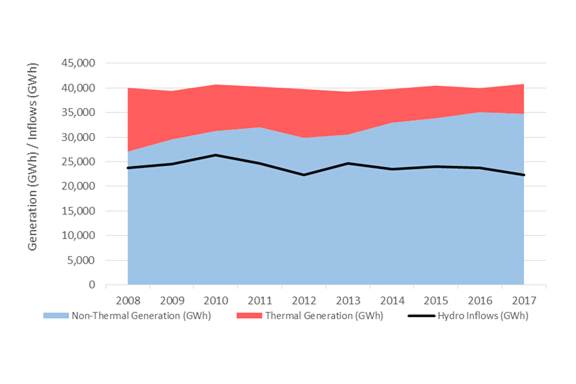A question we often get asked is “With all the renewable energy sources available to New Zealand why do we still need to burn fossil fuels (natural gas, coal and sometimes diesel) to generate electricity”? With climate change becoming an ever increasing threat, it’s a very good question and one we don’t shy from at Contact.
The “Energy Trilemma” provides a useful framework for answering this question. The energy trilemma is a three dimensional problem which involves balancing the security of supply, environmental sustainability and affordability. Thermal generation plays an important role in balancing each issue.
Figure 1. The energy trilemma sourced from the World Energy Trilemma Index 2017 : Monitoring the Sustainability of National Energy Systems

New Zealand’s electricity supply is typically made up of 80%-85% renewable energy (i.e., hydro, geothermal and wind). On average 60% of annual generation comes from hydro, with geothermal and wind contributing 17% and 5% respectively. Thermal energy sources contribute the remaining generation, however, the amount of thermal generation required varies significantly from year to year, depending on the availability of renewable electricity sources.
The high proportion of hydroelectricity and the variability of inflows into the hydro catchments presents a major risk to the security of the electricity supply during period’s low hydro inflows or dry periods. Likewise, during times of high hydro inflows, there’s a risk of inefficient use of the hydro resource if it has to be spilled de to insufficient storage capacity. Since 1999, annual hydro inflows have varied as much as 10% either side of the average (which is equivalent to a possible 6% swing up or down in the supply of electricity generated annually).
The increase of geothermal and wind generation into New Zealand’s electricity generation market has helped to reduce the levels of thermal generation required by the market. While this has improved the environmental sustainability of electricity generation, wind is the least secure source of generation, and geothermal lacks the flexibility to meet the ebbs and flows of electricity users. Thermal generation is critical in providing a flexible and secure generation source, to keep the system balanced. Its use is limited to balancing out the ebb and flow of renewable electricity supply and meeting the peak demand periods over the winter months, rather than providing base load support to the electricity market.

Although higher levels of renewable energy and environmental sustainability are achievable, without alternative technological solutions, Contact believes that the cost of a 100% renewable electricity supply would negatively impact on the affordability of electricity for New Zealanders. This is primarily due to the need to over-build renewable generation sources to deal with the variability of hydro inflows. One outcome may be that hydro lakes would need to be held at higher levels to cover periods of low inflows, and this would increase the risk of spilling water during high inflow events. The increased investment in renewable generation would also need to be recovered.
In recent years, Contact Energy invested in a gas fired peaking plant and gas storage facility. This means we can turn off our thermal generation and store gas when renewable electricity supply is plentiful, and quickly respond to low renewable supply by extracting gas to fire our thermal generation plant. Rather than getting in the way of renewable electricity, thermal generation has supported its expansion by becoming more flexible and adaptable to our rapidly changing electricity market conditions. The affordability, flexibility and reliability provided by thermal generation is one of the reasons why New Zealand was recently ranked 8th in the world on the World Energy Council’s energy trilemma index.








